Magpie
lab constructor
    
Posts: 5939
Registered: 1-11-2003
Location: USA
Member Is Offline
Mood: Chemistry: the subtle science.
|
|
anhydrous formaldehyde
Today I tested an apparatus built for the generation of anhydrous formaldehyde from trioxane.
Trioxane is a cyclic polymer composed of three molecules of formaldehyde linked head-to-tail. It can be decomposed to anhydrous formaldehyde using
acidic catalysts (ref 1). The trioxane I used for this demo is that made for military camp stoves. The package says "trioxane." I don't know if it
also contains some hexamine as a binder.
The catalyst I chose is anhydrous H3PO4 supported on a bed of 4-8 mesh porous volcanic rock. This is landscaping rock that I ground to size using an
iron mortar & pestle. The 10" of catalyst is centered in a 1"ID quartz tube 24" long. The rock is kept in place by about 1" of copper scrub pad
on both ends. This tube was then placed in a tube furnace. All moisture was driven out of the tube by heating at 200-300°C until no fog could be
seen depositing in an air condenser connected to the outlet.
The trioxane gas was generated by heating solid trioxane in a 100mL 3-neck RBF in an oil bath held at 100°C. A nichrome heating coil kept the
trioxane from re-solidifying into 1/2" needles in the feed tube. The trioxane gas was carried by 0.5 SCFH argon into the reactor kept at 220°C.
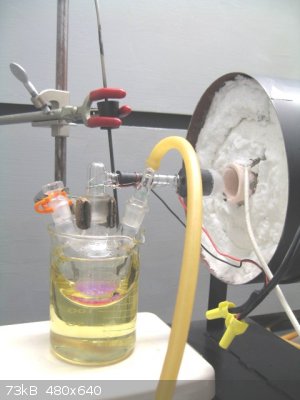
trioxane generator
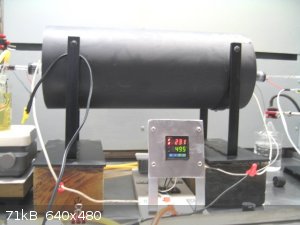
tube furnace with reactor catalyst
The exiting formaldehyde must also be heated to 70-90°C to prevent solidification to paraformaldehyde (ref 2). This was also done with a nichrome
coil. The exiting gas was sparged into 125mL of water in a 2-neck 250mL RBF.
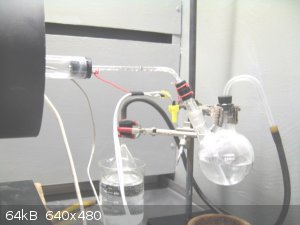
gas exit heater & sparge vessel
I intend to titrate this water for formaldehyde content.
I don't at this time have proof that what I made was formaldehyde rather than trioxane gas. However, I feel that because I saw no solidification
needles at the outlet there was no trioxane at this point. What I did see was a white fog making a thin deposit in the cold parts of the exit tube.
This I presume is paraformaldehyde.
References:
1. US Patent 2,714,616 (Sept 18, 1952), A. W. Schnizer and Gene J. Fisher, "Anhydrous Formaldehyde from Trioxane."
2. US Patent 3,169,840 (Feb 16, 1965), Louis L. Wood, "Method for Removing Water from Formaldehyde."
Questions, comments, and suggestions are welcomed.
[Edited on 9-2-2016 by Magpie]
The single most important condition for a successful synthesis is good mixing - Nicodem
|
|
|
Ozone
International Hazard
    
Posts: 1269
Registered: 28-7-2005
Location: Good Olde USA
Member Is Offline
Mood: Integrated
|
|
Ah, now I see why you are interested in quantifying the product! If you've got it, it's relatively pure, so just about any of the methods cited in
your other thread should do. But, beware that most of them will also hit on paraformaldehyde (fortunately, this is poorly soluble in water).
If you can swing it, I'd recommend (seriously) looking into acquiring a cheap used (VIS) spectrophotometer. You can do a lot with them, and
replacement bulbs can be had easily (see Osram bulbs, they are typical, and in many cases, direct replacements).
O3
[Edited on 9-2-2016 by Ozone]
-Anyone who never made a mistake never tried anything new.
--Albert Einstein
|
|
|
DJF90
International Hazard
    
Posts: 2266
Registered: 15-12-2007
Location: At the bench
Member Is Offline
Mood: No Mood
|
|
I posted a paper elsewhere on the forum not too long ago regarding the preparation of monomeric formaldehyde in ethereal solution (I've attached it
below for convenience). Reference 14 gives details for determination of formaldehyde content by iodometric titration (Helv. Chim. Acta,
1930, pp 43-46, also attached). I've browsed through it but unfortunately you'll need one of our German friends here to help
out.
Attachment: Monomeric formaldehyde in ethereal solution.pdf (85kB)
This file has been downloaded 1944 times
Attachment: Iodometric titration of formaldehyde.pdf (409kB)
This file has been downloaded 411 times
[Edited on 9-2-2016 by DJF90]
|
|
|
Loptr
International Hazard
    
Posts: 1347
Registered: 20-5-2014
Location: USA
Member Is Offline
Mood: Grateful
|
|
Very nice, Magpie! I am jealous of your handy work as always. 
|
|
|
Magpie
lab constructor
    
Posts: 5939
Registered: 1-11-2003
Location: USA
Member Is Offline
Mood: Chemistry: the subtle science.
|
|
Thanks.
Here's a couple pictures of the quartz tube containing the H3PO4 supported catalyst. The white material at the outlet end is paraformaldehyde,
presumably.
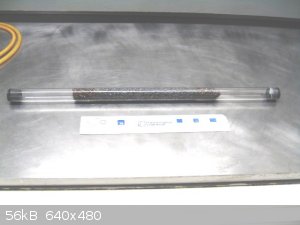 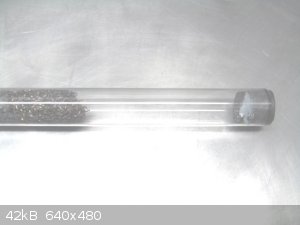
The single most important condition for a successful synthesis is good mixing - Nicodem
|
|
|
BromicAcid
International Hazard
    
Posts: 3227
Registered: 13-7-2003
Location: Wisconsin
Member Is Offline
Mood: Rock n' Roll
|
|
Excellent work Magpie, sorry I missed this being posted. Did you ever get a chance to titrate the formaldehyde you produced? I have recently been
looking into isolation of anhydrous formaldehyde for a project and ran across your post. Thank you for your dedication to the art and science of
amateur experimentalism. 
|
|
|
Magpie
lab constructor
    
Posts: 5939
Registered: 1-11-2003
Location: USA
Member Is Offline
Mood: Chemistry: the subtle science.
|
|
Quote: Originally posted by BromicAcid  | Excellent work Magpie, sorry I missed this being posted. Did you ever get a chance to titrate the formaldehyde you produced? I have recently been
looking into isolation of anhydrous formaldehyde for a project and ran across your post. [/rquote]  |
Thank you Bromic. Yes, you can read about my results here:
http://www.sciencemadness.org/talk/viewthread.php?tid=65275#...
This project was in preparation for the Grignard coupling
posted here:
http://www.sciencemadness.org/talk/viewthread.php?tid=65422#...
It's my pleasure. 
The single most important condition for a successful synthesis is good mixing - Nicodem
|
|
|
XeonTheMGPony
International Hazard
    
Posts: 1636
Registered: 5-1-2016
Member Is Offline
Mood: No Mood
|
|
Very nice apparatus set up!
|
|
|
S.C. Wack
bibliomaster
    
Posts: 2419
Registered: 7-5-2004
Location: Cornworld, Central USA
Member Is Offline
Mood: Enhanced
|
|
BTW...Vogel (5) sez
When dry gaseous formaldehyde is required it may be obtained by the depolymerisation of paraformaldehyde at 180-200°C. For reactions at elevated
temperatures dried paraformaldehyde may be used as the in situ source of formaldehyde.
It refers to the later preparation of cyclohexylmethanol. But, only the second part happens there; Grignard in n-butyl ether at 100-110C. You'd never
know that in the 3rd ed. the first part is given in the notes in the ethyl ether-loving cyclohexylcarbinol entry as an alternative. Then the butyl
ether variation is given.
...in a 500 ml. round-bottomed flask provided with an inlet tube for admitting dry nitrogen. The flask is heated in an oil bath at 180-200°, and
the formaldehyde vapour (produced by depolymerisation) is carried into the Grignard reagent by a slow stream of nitrogen through a wide glass tube (12
mm. in diameter) fitted into the neck of the flask...
[Edited on 13-8-2016 by S.C. Wack]
|
|
|